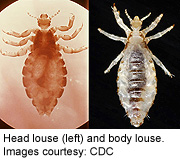
THURSDAY, April 12 (HealthDay News) — Genetic evidence suggests that head and body lice are the same species, a new study says.
The finding is significant because body lice transmit deadly bacterial diseases while head lice do not, the researchers explained.
The researchers compared the number and sequences of all the protein-coding genes expressed at each life-cycle stage of head and body lice and found that the two organisms were very similar.
“The differences in their sequences were so minor that if we didn’t know they were separate groups, we would have considered them the same species,” study leader Barry Pittendrigh, an entomology professor at the University of Illinois in Urbana-Champaign, said in a university news release.
“As body lice transmit diseases and head lice don’t, this system provides a unique opportunity to understand subtle changes that allow body lice to transmit human diseases,” study co-author and University of Illinois graduate student Brett Olds said in the release.
The study appears online and in the April issue of the journal Insect Molecular Biology.
Previous research has shown that even when they are both present on the same person, head and body lice don’t go into each other’s territories, the release noted. There is little connection between human hygiene and head lice, but body lice are quick to appear when there’s a decline in hygiene, such as during times of war or economic hardship.
More information
The U.S. Centers for Disease Control and Prevention has more about body lice.

